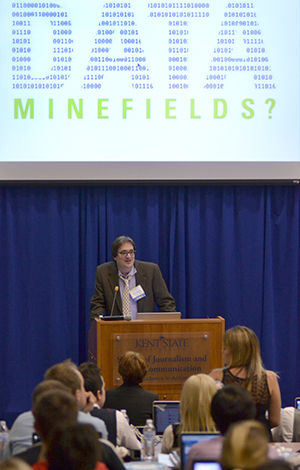Google Glass, technology show future of data journalism at annual Kent State ethics workshop
September 18, 2014
Journalist Robert Hernandez popped Google Glass on his son’s head, gave him a toy airplane and let him run. He played the video to show that Google Glass can be fun but can also serve as a powerful tool for journalists.
However, Hernandez said that no matter how technology changes, journalists still need to inform the public.
“Journalism first, technology second,” Hernandez said. “Before there was Twitter, there was journalism. After Twitter there will be journalism. It will evolve and always be present.”
Hernandez and other speakers discussed topics related to data and journalism at the 10th annual Poynter KSU Ethics Media Workshop “Data Minefields?” in Franklin Hall’s First Energy Auditorium on Thursday.
Keynote speaker Hernandez focused his discussion on new technology and hacking as a way of quickly producing something necessary but not perfect.
“I’m MacGyver for journalism,” Hernandez said.
Hernandez, who referred to himself as a “hackademic”, said he recommends journalists stay informed about new technology so they can continue to tell stories in a relevant way and stay ahead of changes in technology.
Despite his advice, Hernandez, an assistant professor of Professional Practice at University of Southern California Annenberg School for Communication and Journalism, didn’t originally plan to become a journalist.
“He thought he might be a drafting engineer,” said Jan Leach, organizer of the workshop and associate professor of the School of Journalism and Mass Communication. “He walked into a newsroom and discovered — and I believe the exact quote is — ‘the smartest, funniest, nerdiest, socially awkward people’ and decided that’s where he belonged.”
Hernandedz’s class at USC is currently thinking about wearble media technology like Google Glass and what it means for the future of journalism.
Some of the attendees thought Hernandez was humorous.
“He was a great speaker, very humorous. “He gave us some new ways to look at technology as a tool,” said Wendy Turrell, Public Relations Society of America Akron Chapter board member and principal of WordWorks, LLC, a photography company.
Audience members had the opportunity to express their thoughts and ask questions related to the speakers on Twitter, using the hashtag #ksuethics14.
Other workshop sessions included “Countering the Terrorist Threat in the age of Transparency” with Joseph Vealencis, director of the Office of Strategic Communications at the National Counterrorism Center. Vealencis spoke about how the government works to protect the public with the data it collects.
Another session, “What’s on the Menu? A Recipe for Media Mixed with Data,” featured panelists discussing how journalists can use data to create visual, interactive projects online.
For more information about the conference and video of the sessions, visit Kent State’s School of Journalism and Mass Communication’s website.
Contact Julia Kerchenski at [email protected].

























